25.04.2020
SLS Program working on accelerating EUS development timeline
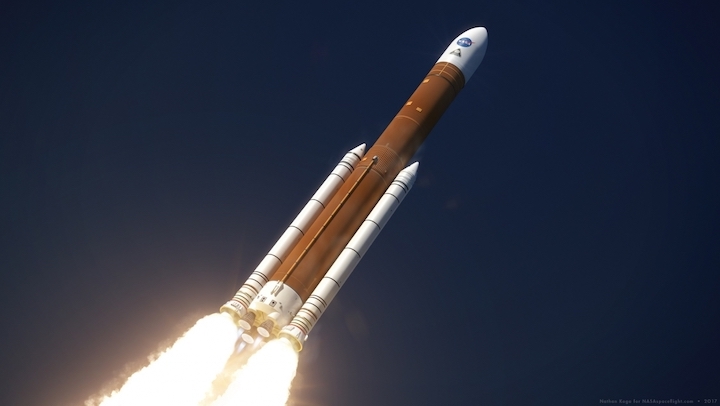
NASA’s Space Launch System (SLS) Program is pursuing ways to accelerate development of the on-again, off-again next evolution of the launch vehicle. The main change from the initial Block 1 vehicle to the Block 1B version of the rocket is the larger, higher performance Exploration Upper Stage (EUS).
Delays primarily with Core Stage production slowed development of EUS and Block 1B as NASA and prime contractor Boeing shifted resources away from the new upper stage. EUS and Block 1B became more controversial over a year ago when the Trump White House concluded that they were unnecessary and began advocating defunding the project; however, key members of Congress remain supporters and funding was restored for the current U.S. fiscal year.
SLS and Boeing began organizational changes prior to the coronavirus disease 2019 (COVID-19) pandemic, relocating NASA people working on EUS development to Boeing offices near the program’s home at the Marshall Space Flight Center (MSFC) in Huntsville, Alabama. The new stage and vehicle design have the potential to deliver over forty metric tons of payload to the Moon in a single launch, which would provide additional flexibility for designers of spacecraft and operational concepts.
Although they were forced like everyone else to adapt their plans to social distancing, the program and prime contractor are continuing to move forward while teleworking and hope to conduct a Critical Design Review (CDR) by the end of the 2020 calendar year.
Moving the architect in with the builder, increased emphasis on the cargo version
Exploration Upper Stage teams working at MSFC for the SLS Program headquartered there had recently moved from worksites in the center to Boeing offices outside the gates of the Redstone Arsenal where MSFC is located.
“We had just initiated a partnership with Boeing where we co-located all that NASA EUS team in the same building with [Boeing’s] EUS team,” NASA SLS Program Manager John Honeycutt said in an April 10 interview. “The intention there was to have the builder working with the architect so that there’s no surprises when you get to the end and you know you’ve got a good, producible design.”
Honeycutt is calling the overall effort, which includes co-locating the teams, an accelerated development activity. Prior to the disruptions brought on by the COVID-19 pandemic, he was looking to hold the Critical Design Review (CDR) by the end of the calendar year, which would be the end of the first quarter of fiscal year (FY) 2021.

Credit: NASA.
(Photo Caption: A graphic showing elements of the Exploration Upper Stage design as updated in 2019. The stage will be built by Boeing and is powered by four Aerojet Rocketdyne RL-10C3 engines. The C3 version of the engine has a two-piece, fixed carbon-carbon nozzle extension attached to the nozzle. In contrast, the RL-10 version used for ICPS has a longer, three-piece nozzle extension that is partially deployed after stage separation and before the first engine start. The engine nozzle is regeneratively-cooled; the nozzle extension radiates away heat.)
“I’ve challenged the team to get it done early in FY ’21 so I’m looking forward to them getting it done probably within the first three or four months of FY ’21,” Honeycutt noted. “That was before the virus and so I don’t understand the impacts there and so we’ll have to go make some adjustments. I’ll get a better view of their schedule as they move over the course of the next three weeks.”
Part of the accelerated development activity is to take another look at the overall requirements with an eye towards shortening the schedule to the first flight.
“The thing that we were going to be able to do with this co-location activity is [to better evaluate if there is] leeway relative to any requirements that the team may find where we might be willing to take some [schedule] relief and expedite that,” Honeycutt said. “John [Shannon] and I agreed that was going to be a huge benefit to us.” Shannon is Boeing’s Vice President and Program Manager for SLS.
“Now that said we’re continuing moving on with that activity but the team is doing it in a virtual environment. From what I see right now we’re on a good pace to have a good shot at [CDR] early in FY ’21.”
“They are teleworking but since this is a development activity we really haven’t changed any of our expectations on dates or productivity and that team so far is just knocking it out of the park on just staying on track with their planning and their development work,” Shannon added. “I think that while we’re off the floor at MAF (Michoud Assembly Facility), most of the EUS work to update the tools had already been done, so now it’s just making sure the design is right, getting the agreements with the suppliers, and working through the process to get to that Critical Design Review at the end of the year.”
The initial Block 1 version of SLS is going through human-rating certification to be able to launch crew on Orion spacecraft beginning with the Artemis 2 launch. In the past Block 1B was planned to quickly replace Block 1 as a crew launcher for lunar missions; now SLS and Boeing are looking at whether some human-rating requirements could be deferred so that the Block 1B Cargo version could launch sooner, complementing Block 1 Crew first and replacing it later.
“My direction to the team is we want to do it smart and if it makes sense to integrate any piece of the human rating for the Block 1B without a tremendous schedule impact we need to go ahead and do that, and then for the things that kind of break us in getting up Block 1B Cargo we’ll have to put those on the shelf,” Honeycutt said.
“Probably the big one is going to be the activity associated with avionics and the human rating there. We’ll end up pushing that out but certainly anything that makes sense to do and saves us money and keeps us on track we’ll look strongly at doing that.”
The Block 1B Cargo variant can deliver more payload mass to a trans-lunar trajectory than the Block 1B Crew version for Orion because the latter launches with additional structural and safety hardware such as the stage adapter that connects the spacecraft to the rocket and Orion’s Launch Abort System (LAS) that doubles as an aerodynamic fairing and crew escape system during the first approximately three minutes of flight. In contrast, on cargo vehicles the payloads attach almost directly to the rocket, have less complicated aerodynamic fairings, and no escape system requirements.

Credit: NASA.
(Photo Caption: A chart of payload fairing options from the most recent public release of the SLS Mission Planner’s Guide in December, 2018. Two options for early Block 1B Cargo missions would be the 8.4-meter USA (Universal Stage Adapter) PLF and the 8.4-meter Short PLF shown in the middle of the chart. The USA was already in development as the Block 1B Crew configuration was expected to fly first. The 8.4m Short PLF designed for Cargo configurations would provide almost double the usable volume of the USA-derived fairing.)
In addition to development of the upper stage, the SLS Program would need to complete first-flight development of the payload attachment system elements. The Universal Stage Adapter (USA) already in development by Dynetics for SLS Block 1B Crew could be modified for payloads with lower volume requirements, but a longer, larger 8.4 meter wide fairing would provide almost twice as much usable volume.
The Exploration Ground System (EGS) Program at the Kennedy Space Center (KSC) in Florida would also need to complete development and assembly of Mobile Launcher-2 (ML-2), which will be used to launch Block 1B vehicles from Launch Pad 39B at KSC.
Doubt about EUS future remains with sustained White House opposition
EUS and Block 1B development remains controversial even as SLS and Boeing move to streamline work. The White House remains strongly opposed to any further EUS/Block 1B spending, which they argue is unnecessary for a long time.
In the President’s Fiscal Year 2021 Budget Request published in February, the Office of Management and Budget highlighted the cost savings of cancellation, saying that SLS “is facing significant cost, schedule, and management challenges resulting in billion dollar cost overruns and multiple-year delays” and that NASA should focus on flying the first SLS flight “before engaging on a costly multi-year Block 1B upgrade program that is not needed for lunar exploration over the next decade.”
“Competitively procuring commercial launch vehicles to carry cargo as a complement to crewed SLS launches will speed up lunar exploration plans and save money in 2020 and future years that will be critical for supporting exploration activities on the lunar surface in a sustainable manner,” they added. Defunding EUS and ending further development was first proposed by the White House in their FY 2020 budget proposal.
The upgrades have key supporters in Congress, though, and appropriation bills passed there have consistently included language over the last decade mandating higher SLS performance and funding since FY 2016 specifically for EUS. Development was suspended and the EUS budget was cut from $300 million to $150 million in FY 2019 to focus on finishing the Block 1 vehicle and flying it for the first time on Artemis 1; NASA was already re-evaluating schedules that forecast the Artemis 1 launch in 2021 before COVID-19 became another factor.
Boeing’s redesign of the stage was completed last year and approved by NASA and the prime contractor made the Block 1B part of the foundation for its Human Landing System (HLS) proposal submitted in November for Artemis, which prioritizes the goal of landing U.S. astronauts on the Moon again by the end of 2024 during the Artemis 3 mission. Boeing’s proposal would require delivery of both the first EUS for flight and two Core Stage units by the middle of 2024, a time-frame where NASA only expects a single Core.
Top NASA officials expressed skepticism for both possibilities during Congressional testimony in the middle of 2019 and again late in the year that EUS could be ready for a first launch in time to support the prime Artemis objective. Congress included $300 million for EUS in the FY 2020 budget, but the White House continues to advocate canceling the effort altogether.

Credit: NASA.
(Photo Caption: A slide from a February presentation by the SLS Program showing characteristic energy (C3) performance for different heavy-lift launch vehicles. The curves for the two SLS cargo configurations appear to based on a data update more recent than the late 2018 Mission Planner’s Guide numbers. As the chart states the data for the commercial vehicles is from NASA’s Launch Services Program (LSP); what isn’t clear is how recently the LSP data plotted here was updated.)
NASA’s FY 2021 budget submission in February deletes funding for not only EUS but also ML-2, which would be unnecessary if EUS is canceled. “Although NASA began design and construction of the second mobile launcher platform, additional funding to complete the project is being deferred,” the submission notes. “NASA does not have plans to utilize the second mobile launcher in the near-term.”
Even with recent hints of changes, given the strong opposition from the White House, any involvement of EUS and Block 1B in NASA’s Artemis architecture would be a significant departure from the agency’s plans.
As noted by OMB, with the initial configuration behind schedule, still in development, and yet to fly for the first time, the only role SLS currently has in Artemis is as a crew launch vehicle. All the enabling infrastructure in the Artemis reference architecture from Gateway modules to lunar lander stages to surface logistics will be launched on commercial rockets such as the SpaceX Falcon Heavy that is flying today and others in private development that NASA does not have to directly fund.
The Block 1B Cargo variant is only being advocated outside the space agency in alternate lunar architectures. Studies such as one published by Aerojet Rocketdyne concluded that the higher predicted performance capability of SLS to the Moon would reduce the complexity of the lunar lander spacecraft and the landing mission itself, which would reduce HLS development risks to the end of 2024 goal.
(The study is available in the Future In-Space Operations (FISO) Telecon Presentations Archive. Titled “Analysis of the Utility of Various Human Landing System Architectures,” it was presented on January 29.)
Quelle: NS
----
Update: 1.05.2020
.
New report says SLS rocket managers concerned about fuel leaks
“Should leaks or other issues be discovered, the program will need time.”
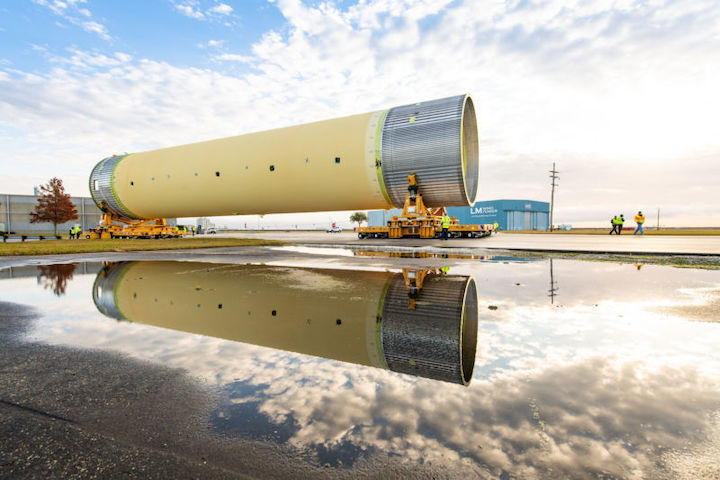
Technicians at NASA’s Michoud Assembly Facility in New Orleans moved the Space Launch System's liquid hydrogen tank from the factory to the dock, where it was loaded onto the Pegasus barge on Dec. 14, 2018.
Every year, the US Government Accountability Office releases a report that assesses NASA's major projects. Typically, this GAO report summarizes each project and provides some basic information about schedule, cost, and concerns regarding the space agency's work.
However, the new "Assessments of Major NASA Projects" report released on Wednesday contains what seems to be an entirely new bit of information about the Space Launch System rocket NASA is developing for deep space exploration. The report asserts that engineers at NASA and the SLS rocket's core-stage contractor, Boeing, are concerned about fuel leaks.
Earlier this year, NASA moved the big rocket's core stage to a test site at Stennis Space Center in southern Mississippi. Before the COVID-19 pandemic temporarily halted work, NASA and Boeing teams were working toward a critical summer exercise. During this "green run" test, the clamped-down rocket will ignite its engines and burn for about eight minutes to simulate an ascent into orbit.
"Program officials indicated that one of the top remaining technical risks to the green run test is that the core stage may develop leaks when it is filled with fuel," the report states on page 82. "According to these officials, they have conducted extensive scaled testing of the gaskets and seals used in the core stage; however, it is difficult to precisely predict how this large volume of liquid hydrogen will affect the stage."
Launch slipping more?
The lead author of the new report, Cristina Chaplain, director of Contracting and National Security Acquisitions for the GAO, did not immediately respond to a request for more information about this issue. NASA has not publicly discussed these concerns.
Boeing, the prime contractor, began work on the SLS core stage nearly a decade ago, and NASA has invested about $10 billion into the program to develop this stage alone. The SLS core stage is very large, but at its essence, the vehicle represents fairly standard aerospace fare, with big liquid-hydrogen and liquid-oxygen fuel tanks and a plumbing system for four rocket engines. The engines for the SLS rocket are holdovers from the space shuttle program, and other contractors are working on the side-mounted boosters (Northrop Grumman) and upper stage (United Launch Alliance) for the first flight of the complete rocket.
Fuel leaks could have a significant effect on the SLS program's schedule. "Should leaks or other issues be discovered, the program will need time to assess and mitigate difficulties or glitches, which could delay shipping the core stage to Kennedy Space Center and the enterprise integration and test schedule," the report states.
NASA has yet to provide a new formal launch date for the SLS program. Originally intended to launch in 2017, the launch date has slipped several times until it is now expected to fly no earlier than the second half of 2021. However, due to the COVID-19 situation, further delays are likely, and any significant issues with fuel leaks would certainly set the launch date back further. It seems increasingly likely that the SLS rocket that will power the Artemis I mission for NASA will not be ready to go until 2022.
Quelle: arsTechnica
----
Update: 3.05.2020
.
Hopeful for launch next year, NASA aims to resume SLS operations within weeks
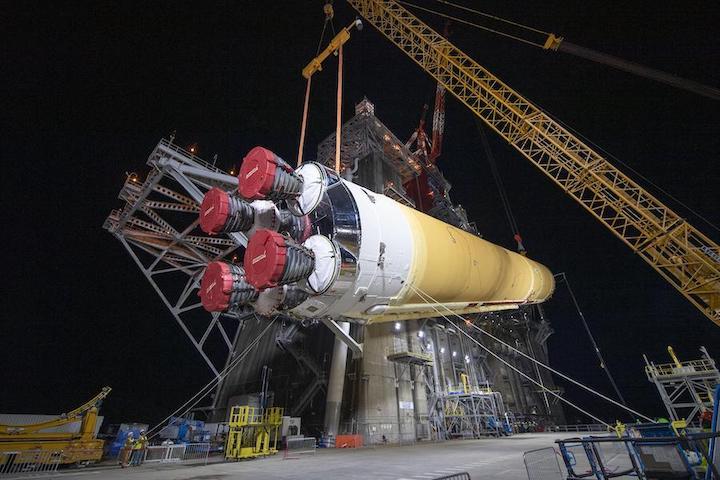
With the Space Launch System’s inaugural test flight now officially delayed to November 2021, NASA says work halted by the coronavirus pandemic will resume within weeks to prepare for the first test-firing of the SLS core stage at the Stennis Space Center in Mississippi.
The last official schedule from NASA had the first SLS test launch in March 2021, but managers have said for months that schedule was no longer achievable. After a thorough review, NASA says the first SLS launch — named Artemis 1 — is now planned in November of next year.
The most powerful launch vehicle since the Apollo-era Saturn 5 moon rocket, the Space Launch System will carry an unpiloted Orion crew capsule into space. The Orion spaceship will orbit the moon to demonstrate the capsule’s capabilities and performance before NASA commits to flying astronauts around the moon on the second SLS/Orion flight in late 2022 or early 2023.
According to NASA’s current plans, the Artemis 3 mission — scheduled as soon as 2024 — will send astronauts back to the moon on the third SLS/Orion flight. Once in lunar orbit, crew members will dock with a lunar lander and attempt a landing near the moon’s south pole.
But the development of the Space Launch System, which kicked off in 2011, has faced ballooning costs, delays and a change in strategy ordered after the Trump administration took office in 2017. Since then, the White House has directed NASA to accelerate the return of U.S. astronauts to the lunar surface to 2024.
Years behind schedule, the march toward the first SLS test launch hit another hurdle in March when NASA ordered teams at the Stennis Space Center to pause operations on the B-2 test stand, where the heavy-lift rocket’s core stage arrived in January from its factory in New Orleans.
“We basically shut down operations there March 17,” said Doug Loverro, associate administrator for NASA’s human exploration and operations mission directorate.
Originally scheduled for a debut test launch in 2017, the Space Launch System has faced repeated delays, primarily due to difficulties in building the rocket’s first flight-ready main stage, a large structure with cryogenic liquid hydrogen and liquid oxygen propellant tanks measuring 212 feet (64.6 meters) long.

The core stage — built by Boeing — finally left its factory at NASA’s Michoud Assembly Facility in New Orleans earlier this year. In January, the stage arrived at the B-2 test stand at Stennis, the same facility once used for test-firings of the main stage of NASA’s Apollo-era Saturn 5 moon rocket.
Before the pandemic hit, NASA and contractor teams were readying for a test-firing of the SLS core stage’s four hydrogen-fueled RS-25 main engines as soon as early August. Known as the green run, the test is the culmination of the core stage’s construction and test campaign before delivery of the rocket to the Kennedy Space Center in Florida to final launch preparations.
In mid-March, rising numbers cases of the COVID-19 viral disease in the area around the Stennis Space Center — including the first confirmed positive case among the Stennis workforce — prompted NASA to stop work on the test stand. NASA also paused production of hardware for subsequent SLS launches at Michoud.
“There’s no question we’re going to lose some time to (the coronavirus pandemic), but we’ve tried to go ahead and maximize what we’ve got done,” Loverro said in an interview Wednesday. “And we’re right now working the reopening plans … For each activity that we’re doing, we are putting together a specific plan.”
In a sign that operations at Stennis are beginning to resume, Loverro said NASA has approved the painting of a different test stand used to to test-fire individual RS-25 engines that are used on the SLS core stage.
“We have three other plans in work right now that will be submitted later this week to restart work at MAF (the Michoud Assembly Facility), and restart work at Stennis in different areas,” Loverro said.
“We are going to be resuming work on the B-2 test stand in support of green run within the next couple of weeks,” Loverro said. “It won’t be at full speed, but it will be done in a safe manner so we can protect our Boeing and NASA workers down there. And we will work on the engine section, we’ll work on the thermal protection system. Each element will be started when we have the plans and the gear ready to protect those workers.”
Loverro said NASA and contractor teams continued with virtual training sessions and reviewed paperwork.
“It’s often the case in these developments that the last thing that gets done is the paperwork, so we decided that we’d get ahead on the paperwork and get a lot of it signed off. And the software development has still continued as well,” he said.
Loverro, a veteran manager in U.S. military space programs, led a comprehensive review of the SLS and Orion schedules since arriving at NASA late last year.
“We went through an entire re-baseline of the program,” he said. “We looked at every schedule, and we came to the conclusion that we had a very high confidence date of November 2021.

“There’s no question the COVID shutdown puts pressure on that date that we had not anticipated,” Loverro said. “I would say the work and the experience that Boeing has done so far in green run gives me great hope and confidence that they are going to get back into this and get us very near to the original schedule on this.”
He said NASA and Boeing teams at Stennis were working 10 days ahead of schedule during the green run test campaign before the shutdown in March.
“So performance was excellent,” Loverro said. “Assuming we can get back to work in the next several weeks, I think that November 2021 date is still going to hold.”
Development of the Orion spacecraft, led by Lockheed Martin and Airbus Defense and Space, has encountered its own delays. But the spaceship is on track to be ready to begin Artemis 1 launch preparations within the next few months, well ahead of the SLS timeline.
The Orion spacecraft for Artemis 1 arrived back at the Kennedy Space Center in March after thermal vacuum and electromagnetic testing at NASA’s Plum Brook Station in Ohio.
“We were able to continue with Orion using the right protective gear to make sure we took care of our people and the Lockheed people,” Loverro said. “We were able to continue with that, not as we would normally do it. But under very safe conditions, we were able to continue work there, and in fact have progressed.”
A Government Accountability Office report released this week said one of the top remaining technical risks with the Space Launch System’s core stage is that the rocket may develop leaks when filled with cryogenic liquid hydrogen and liquid oxygen for the first time.
NASA plans to load 730,000 gallons super-cold propellants into the rocket during a rehearsal for the green run test-firing. If all goes according to plan, engineers would follow the fueling test — called a wet dress rehearsal — with another propellant load culminating in a burn of all four RS-25 main engines lasting more than eight minutes.
“The next big unknown as a program is when we put the cryogenic liquids in the oxygen tank and the hydrogen tank, and we look at the plumbing and all the systems and make sure that they remain tight, and that they perform as expected through our qualification test,” said John Shannon, Boeing’s SLS program manager, in January. “We have high confidence that they will, but until you see it in an integrated fashion, you don’t really know.”
NASA has spent more than $15 billion on developing the Space Launch System since 2011.
“The program reported further development cost growth of $700 million since 2019, for a total increase of approximately $1.7 billion — or 24.6 percent — above the program’s development baseline,” the GAO reported of the SLS program this week.
Those figures assumed the SLS could lift for the first time in March 2021, a schedule that is no longer achievable.
Quelle: SN
----
Update: 17.05.2020
.
Stennis returning as battle to protect SLS maiden launch in 2021 restarts

Hands-on operations with the Space Launch System (SLS) resumed this week, following a lengthy standdown due to the restrictions relating to COVID-19. This included a return to Green Run preparations at the Stennis Space Center, with “limited crews” preparing the Artemis-1 core stage on the B-2 test stand for what will be one of the most defining tests relating to the launch date. That maiden launch of NASA’s new rocket is awaiting a realigned launch date, which officials cite will be moved to “late 2021”.
The Green Run, which at one point was set to be deleted from the test flow to attempt to protect SLS’ schedule, will involve the Core Stage’s four RS-25 engines firing up on B-2 to provide key validation of the hardware’s readiness ahead of being shipped to the Kennedy Space Center (KSC).
The Green Run was still awaiting a firm date for the milestone firing, although the overall goal was to complete testing “in the summer” in preparation for a trip on the Pegasus Barge to Florida later this year.
However, Stennis moved to “Stage 4” – per the COVID shutdown – on March 16, with only the personnel needed to perform mission-essential activities related to the safety and security of the center allowed on site.
“Though Stennis remains in Stage 4 of NASA’s COVID-19 Response Framework, we assessed state and local conditions and worked with agency leadership to develop a plan to safely and methodically increase critical on-site work toward the launch of the next great era of space exploration,” noted Stennis Center Director Rick Gilbrech.
Key SLS centers, such as Marshall and Michoud are also are in Stage 4.
Work to bring the B-2 Test Stand out of its slumber includes restoring facility power and controls, as well as ensuring pressurized gas systems are at proper levels for SLS operators to proceed with testing activities.
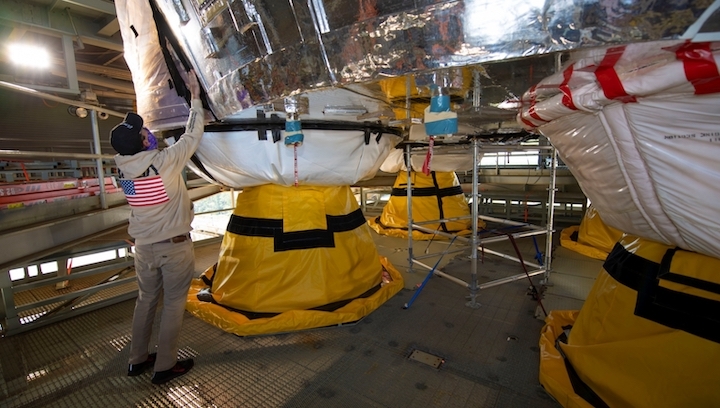
“The test facility has been in standby mode, so we allotted two days to reestablish some facility support of mechanical and electrical systems that will also assist the vehicle contractors in performing their operations,” added Barry Robinson, project manager for the B-2 Test Stand SLS core stage Green Run testing at Stennis.
Following modal testing to validate structural analysis on the vehicle, the Stennis team had connected feed and pressure lines. They had about 10 days worth of integration work to get to “phase one” test activity when the center halted operations due to COVID restrictions.
A handful of workers remained on-site to keep the Core Stage safe and watch for water intrusions during several documented “rain days”.
With more workers returning to the B-2 stand, teams will start the ramp-up to phase one testing, starting with electrical checkouts, working through an avionics checklist and driving the Trust Vector Control (TVC) system for the engines.
With the flagship event of the Green Run being an eight-minute, full-duration hot fire of the core stage with its four RS-25 engines, passing that phase – and being ready to ship the stage to KSC – will provide schedule guidance, which has been fluid throughout the lifetime of SLS.
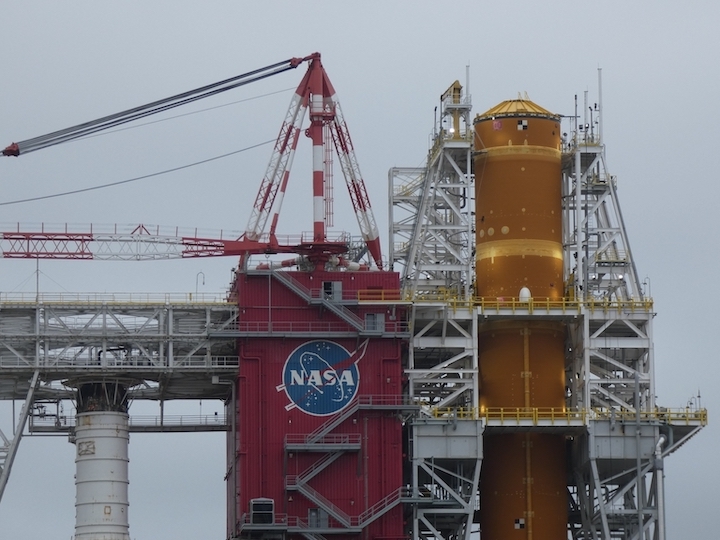
The Green Run was tracking an August test, which is now expected to occur sometime in mid-autumn – followed by shipping to KSC at the end of the year, or early in 2021.
Ahead of the next schedule realignment, which is set to occur next week, Tom Whitmeyer – NASA assistant deputy associate administrator – provided an overview at the NASA Advisory Council’s Human Exploration and Operations Committee.
Unsurprisingly, the anchor item for the overview was the status of the Green Run.
“The one thing that we’re really in the process of doing right now is that middle item, the core stage, it’s been manufactured and delivered to Stennis. It’s sitting in the test stand at Stennis, the B-2 test stand. We really need to get through what we call the Green Run test,” Mr. Whitmeyer said.
“When we complete the Green Run test, we’ll take that core stage, and literally begin to build up this integrated stack, test it at the Cape, and then fly it. We bring the motors in first, and then we drop the core stage in, and then we actually stack the rest of the vehicle. We’ll do a Wet Dress Rehearsal (WDR) next year, then we’ll get ready to fly.”
When the Core Stage arrives at KSC, it will be greeted in the Vehicle Assembly Building by the Mobile Launcher with the two Solid Rocket Boosters already stacked on its deck. This follows a similar path to during the Shuttle era, where the boosters would be “built-up” on the Mobile Launch Platform, ahead of receiving the External Tank.
The booster segments for Artemis-1 are already built and preparing to make the train journey from Utah. The latest L2 schedule for transportation cites a NET (No Earlier Than) departure date of next week, on a journey that will take around three weeks before arriving into KSC.
“Right now we currently have all the motor segments we need for this flight out in Utah, (stored) there to keep them dry,” added Mr. Whitmeyer. “Then what we will do is we will begin to transport those motor segments towards the KSC, and they’ll be delivered by rail car to KSC in the mid-June timeframe.”
The final element to be stacked in the VAB will be the Orion spacecraft, which is currently in storage at KSC after completing most of its pre-flight assembly.
“We actually have Orion, almost in a completed state, put it in temporary storage at this point – (ready to) begin the flight preparation processes with the completed vehicle, which involves putting high-pressure helium in its tanks and beginning the bi-prop loading operations at the Cape,” Mr. Whitmeyer continued.
“And by the time we have that completed, we should be in a stacked configuration with the core stage, and we’ll actually begin the integration of Orion then, to the vehicle.”
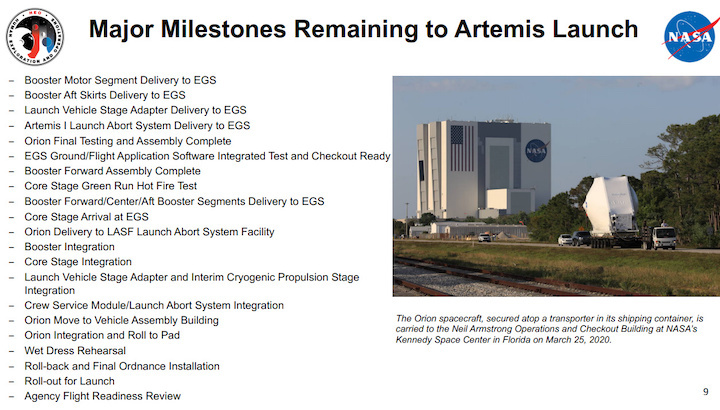
Per the launch date, the latest realignment was tracking a Summer 2021 launch of Artemis-1, before the COVID restrictions halted the bulk of SLS preparations. The SLS schedule has been slipping an average of one year, each year – although recent schedules had begun to slip only by a matter of months.
“We had for a year now maintained our schedule, in terms of getting that work done. We had some earlier delays in the program, but I think (recent schedules were) an indication of things that had really turned around with manufacturing and processing activities,” added Mr. Whitmeyer.
“SLS, the Marshall folks working with the Boeing team, had created a lot of manufacturing practices and really improved how we were going through these operations. And they held schedule for the entire year, and they actually held schedule when we got to Stennis, up to the point when we had temporary hold operations for the virus.”
Although Mr. Whitmeyer wouldn’t commit to an actual launch date, several references to the end of 2021 were made, ahead of next week’s official schedule announcement.
“That’s the reason I started with the mission map. It’s an incredible journey, it’s going to be an incredible flight for this hardware. And we’re going to really take it a step at a time and make sure we’re ready to commit ourselves to a launch later next year.
“We’re feeling fairly comfortable that we will be having the Artemis 1 mission towards the end of next year.”
Quelle: NS
